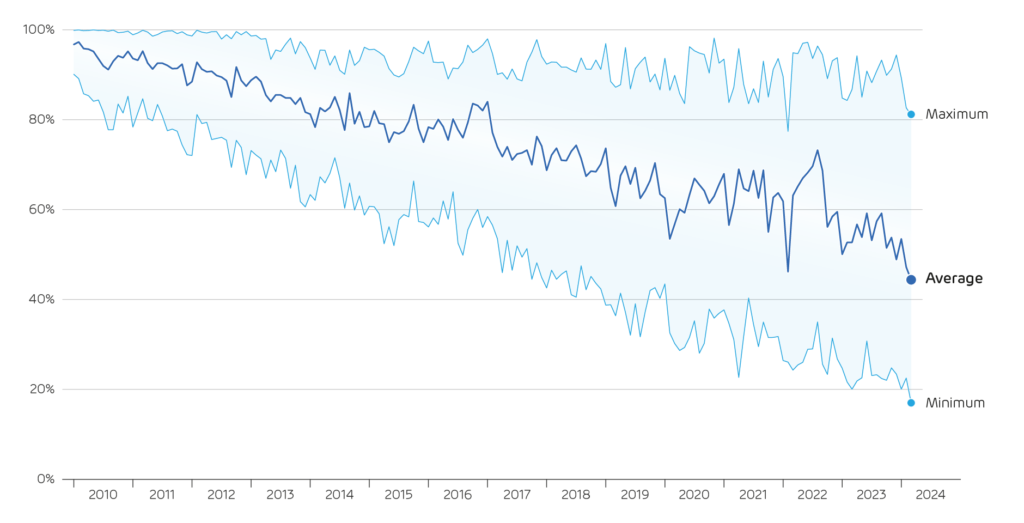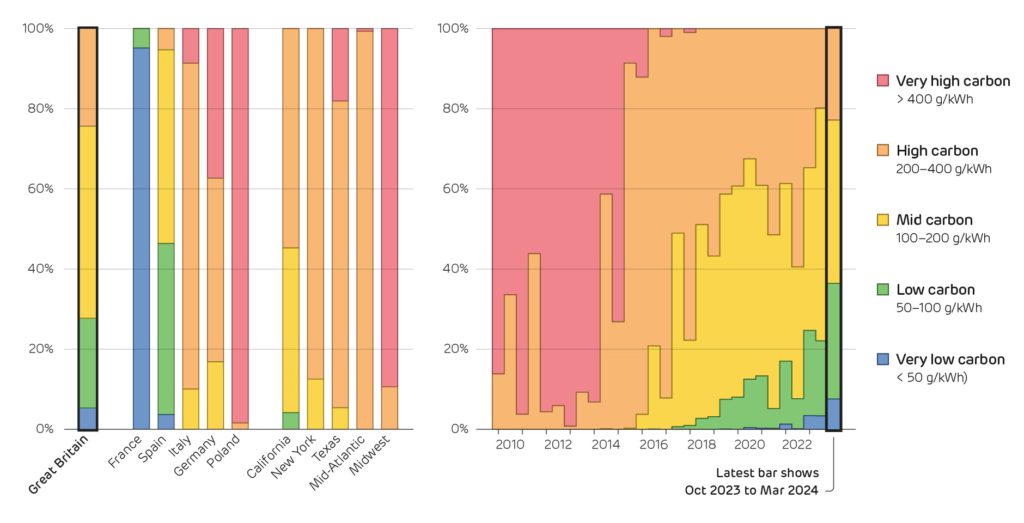Q1 2024: Moving towards zero-carbon electricity
Download PDF
Electricity has played a major role in the UK’s national decarbonisation, and the power sector is continuing on its path towards zero emissions. Last year’s generation mix was the cleanest on record, and 2024 continued this trend with emissions staying below 150 g/kWh for the third quarter running.
National Grid reported a new record low for carbon intensity on 5 April of just 21 g/kWh [1]. Just 10 days later this record was broken again, reaching 19 g/kWh on 15 April. The latter was recorded on a sunny Tuesday afternoon. Demand was near its highest for the day, at over 39 GW, but wind and solar generation combined were able to meet 70% of this. Nuclear power contributed another 13%, and 10% of demand was imported (counted as zero-carbon when calculating British emissions). Biomass supplied about 3% and hydro another 1%, leaving only 3% of demand to be met by gas and coal.
Wind, solar and imports accounted for four-fifths of demand, which appears to be the current limit for these “nonsynchronous” electricity sources. Power stations which use turbine generators (fossil, biomass, hydro or nuclear) are synchronised to the grid, rotating at exactly the same speed: the system frequency. Maintaining that frequency depends on the power flowing into the grid being perfectly balanced with the demand drawn from it. The sudden failure of a generator can lead to a sharp drop in frequency, which could lead to widespread blackouts if not corrected for. Turbines store some energy in the form of “inertia” due to their heavy rotating mass, and this reduces the rate at which the frequency is falling, giving more time for other corrective actions.
Non-synchronous sources of electricity (wind, solar, interconnectors) are instead connected via power electronics and do not naturally provide inertia, which leaves the system more vulnerable. System operators therefore limit the amount of non-synchronous energy they will accept at any given time to keep a minimum level of inertia, even if this means constraining off wind power. Moving forwards, fastacting batteries can reduce the need for inertia, and system operators have been developing other techniques for running a low-inertia power system. Over the last few years, Eirgrid has steadily increased the maximum proportion of wind power it is prepared to admit onto the Irish power system.
The falling share of synchronous generation in the British electricity mix since 2010.

This is not just an issue at the extremes when carbon records are being broken. Over the last year, Britain has been seen twice as many hours when electricity falls below 50 g/kWh, at which point synchronous generation is typically below 30%.
Looking at the biggest countries in Europe, Britain’s emissions from the power sector are comparable to those in Spain. Both countries see a wide range in carbon intensities: power is clean when the weather allows for it, and is higher carbon otherwise. Germany and Italy have notably higher carbon intensities, never going below even 100 g/kWh. Despite having high shares of renewables, they are still heavily reliant on coal. Conversely, France almost always benefits from very low carbon electricity due to the high share of nuclear power.
Across the Atlantic, all of the USA’s largest markets have dirtier electricity than Great Briain, as they are both behind on renewables share and behind on coal phase out.
The growing frequency of “very low carbon” generation (under 50 g/kWh) is part of a shift that has been progressing for the last decade – the near-total phase out of coal power and continuing growth in renewable generation. Electricity in Germany or Texas has a similar mix of carbon intensities that Britain had 8 years ago, back in 2016. Poland and the US Midwest are closer to Britain a decade ago. The cleanest electricity in the US is in California, but this is not yet seeing hours with under 50 g/kWh, roughly where Britain was two years ago.
Technical constraints on balancing the grid mean there is a limit on how low carbon our electricity can go. National Grid are working to overcome these barriers, and by next year they aim to be capable of running the power system for hours at a time with zero carbon emissions, meaning that it can remain stable with just the synchronous generation from nuclear, biomass and hydro. This will require many changes: more flexibility (storage, interconnection, and demand side response), and innovation both in system management and market designs.
Left: The range of carbon intensity across all hours of 2023 in Britain, compared to the five largest electricity markets in Europe and the United States.
Right: The distribution of carbon intensity of electricity in Britain since 2010, split between winter and summer months.

[1] Note, we report this as 28 g/kWh when accounting for the emissions from generating the electricity we import.